Holy relics: the strange practice of venerating human remains
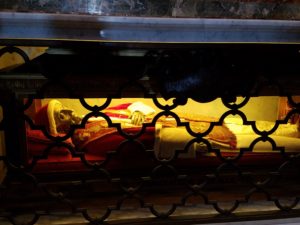
- Suzette’s Cancer Journey - September 8, 2023
- My Black to Green Thumb - March 15, 2023
- Suzette and her three husbands by Suzette Standring - March 4, 2023
Eek alert! In Italy I saw many body parts of saints on display in basilicas and museums. They represent a centuries-old Roman Catholic belief that the bodies of saints manifest holiness, and therefore, are to be venerated. It’s very odd.
Take for example, St. Catherine of Siena (1347-1380), a mystic who worked toward peace within the church. She persuaded Pope Gregory XI to move from France, where many popes had ruled, and to return to Italy, restoring it as the seat of papal power. She is the patron saint of Italy along with St. Francis of Assisi.
Under glass, the finger of Saint Catherine points ever upward. It’s next to a box displaying her whip of metal links used for self-flagellation. Rather ghoulish is her severed head framed on an altar for distant viewing, all at her namesake cathedral in Siena, Basilica Cateriniana San Domenico.
But wait. I saw more. At the Museo dell’Opera del Duomo in Florence, the Reliquary Chapel holds 600 relics. Displayed are the finger of John the Baptist, along with a segment of his jawbone and one tooth, along with bits of St. Jerome, bishops and apostles.
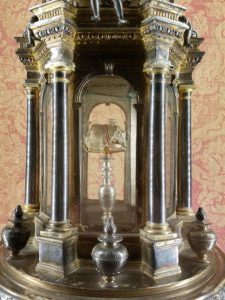
A jawbone segment of St. John the Baptist (Florence, Italy)
The artwork of each reliquary is ornate and elaborate, but then, the entire museum is devoted to genius masterpieces and architectural wonders connected with the history of Florence’s Duomo, the Cattedrale di Santa Maria del Fiore, which dates back to 1294.
Italy is sensory overload.
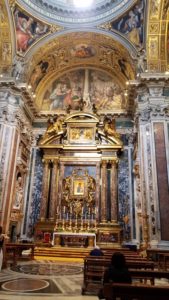
Painting of Mary and Jesus is done by Luke the Apostle. The Cathedral of Mary Maggiore in Rome.
At St. Peter’s Basilica in Vatican City, several giant monuments honor Catholic popes. At the base of an altar, the full remains of Pope Innocent XI (1611-1689) are displayed in a glass coffin. Historically, he helped the poor and fought corruption and nepotism within the church. In his resting place, Pope Innocent XI is dressed in red robes and slippers, with a wax face and hands, but our guide assured me, “Those are his real bones underneath.” He looked like a thin Santa Claus in a glass box.
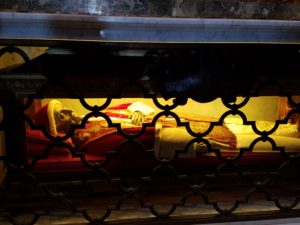
Pope Innocent’s body on permanent display at St. Peter’s Basilica in Rome.
Relic containers or “reliquaries” typically hold smaller remains and, according to our guide, in medieval times it was a way to draw thousands to the host cathedral. Such items were revered as holy, with possible curative or miraculous powers.
Much to my surprise, this practice continues, but with updated rules for stricter handling. For example, consent of family members is now required, and nothing can be sold by auction or on-line.
Perhaps some feel a sense of spiritual wonder at being “that close” to say, the remains of John the Baptist. To each his own. For me, the “eek factor” is a distraction, but on the plus side, it did compel me to research their lives.
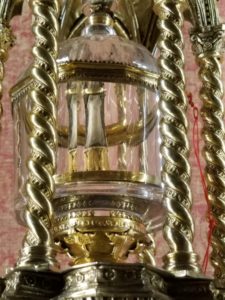
The finger of St. John the Baptist, Florence, Italy
Viewing preserved human remains was a macabre experience for me, and my modern mindset tries to understand its value.
I distilled it down to this: when you’re famous, everybody wants a piece of you.